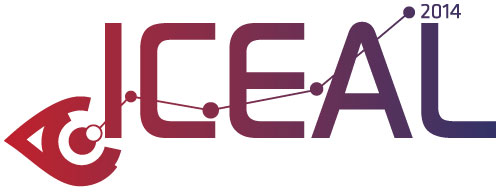„Can these eyes lie?"
International Conferencje on Eyetracking and Applied Linguistics
How we look, where we look and why? - there were the questions for participants of International Conference on Eyetracking and Applied Linguistics called „Can these eyes lie?", which took part on 26-27th of September 2014, at the Faculty of Applied Lnguistics at University of Warsaw. The Conference was organized by the Institute of Anthropocentric Linguistics and Culturology (at present: Institute of Specialized and Intercultural Communication) in cooperation with University of Mainz and NeuroDevice. During two days of the Conference it was about 30 presentations devoted to the application of eyetracking in linguistic studies. The Conference was attended by approx. 50 most famous scientists from Polish and international research centres, involved in eyetracking linguistic studies.
The Conference was opened by prof. Sambor Grucza and prof. Silvia Hansen-Schirra. The keynote speaker was prof. Arnt Lykke Jakobsen, world-renowned specialist in the field of translation, who delivered a lecture titled Looking at translators' eyes.
On the first day of the Conference, during 2 sessions (each session was divided into 2 thematic sections) it was 16 presentations. The first session concerned web usability and dictionaries:
-Sascha Wolfer & Carolin Müller-Spitzer – Evaluation of a New Web Design for the Dictionary Portal OWD;
-Christoph Rösener – Eyetracking and Beyond – The Do's and Don't of Creating a Contemporary Usability Lab;
-Shaimaa Marzouk – Web Usability from a Linguistic and Formal Perspective: Applied on the Example pf Academic Websites;
-Robert Lew – Eyetracking in Dictionary User Research),
and also the application of eyetracking in translation:
-Bogusława Whyatt, Marta Kajzer-Wietrzny & Katarzyna Stachowiak – A Comparative Analysis of Reading Patterns in Interlingual and Intralingual Translation: An Eyetracking Study;
-Michael Carl & Moritz Schaeffer – Literal Translations and Cognitive Effort;
-Maureen Ehrensberger-Dow, Peter Jud & Gary Massey – The Cognitive Ergonomics of Translation: Indicators from Eyetracking Data;
-Arndt Heilmann & Tatiana Serbina – Grammatical Complexity and its Effect on Cognitive Processing in Translation.
The second session was devoted to interpreting:
-Kilian G. Seeber – Attentional Shifts during Simultaneous Interpreting;
-Sabine Seubert – Cognitive Load, Visual Over-load;
-Paweł Korpal & Katarzyna Stachowiak – How do Simultaneous Interpreters Cope with Numbers in the Fast Speech Condition? An Eyetracking Study;
-Anne Catherine Gieshoff – Visual Input and Mental Effort in Simultaneous Interpreting
and language acquisition:
-Natalia Ilin, Sascha Wolfer, Lars Konieczny & Bernd Kortmann – Perception of Learner Errors and Nonstandars Features in Native and Non-native Language;
-Ewa Tomczak – Does Figurative Language make you Look at the World Differently? – Processing of Fictive Motion Sentences in Polish-English Bilinguals;
-Katarzyna Kosmowska, Agata Rodziewicz, Justyna Iwańska, Agnieszka Gajos, Izabela Krejtz & Krzysztof Krejtz – Comparison of Eye Movements during Text and Music;
-Alper Kumcu – Integrating Auditory and Visual Language: An Eyetracking Study on Multimodal Language Processing).
The summary of the first day of the Conference was the presentation titled PopSci: A reading corpus of popular science texts devoted to the study on reading corpus, presented by Sascha Wolfer.
During the second day of the Conference it was also 16 presentations. At the first session the participant focused on audiovisual translation:
-Agnieszka Szarkowska & Izabela Krejtz – Age-related Differences in Reading Subtitles: An Eyetracking Study;
-David Orrego-Carmona – Different Audiences, Different Behaviors: On the Reception of Subtitles by Users with Different Levels of 12;
-Minako O'Hagan & Ryoko Sasamoto – Crazy Japanese Subtitles – Shedding Light on the Impact of Impat Captions;
-Juha Lång – Comparison between People from a Dubbing vs. a Subtitling Country in the Comprehension of a Television Documentary;
-Wendy Fox – Reception, Information Flow and Aesthetics: Integrated Titles and other Possible Improvements
and different aspects of the application of eyetracking in translation studies:
-Igor Antonio Lourenço da Silva & Adriana Silvina Pagano & Fabio Alves – Mapping Gaze onto Representations of Text Rhetorical Structure;
-Jin Huang & Akshay Minocha – A Comparison of the Process and the Product of Translation Self-revision and Other-revision;
-Silke Gutermuth – Lost in Sign Language Interpretation – An Eyetracking Study on the Visual Attention of Hearing Impaired Recipients;
-Annegret Sturm – Through Others' Eyes.
During the second session were presented the results of studies devoted to post-editing machine translation:
-Fabio Alves et al. – Investigating Cognitive Effort in Post-Editng: A Relevance-Theoretic Approach;
-Moritz Schaeffer, Michael Carl, Mercedes García Martínez & Bartolomé Mesa-Lao – Tracking Post-Editing Performance with CASMACAT 3.0;
-Jean Nitzke – Human Translation vs. (Post-) Editing: A look At Conscious Problem-solving Startegies (Internet Research)
oraz reading texts:
-Sascha Wolfer, Sandra Hanses-Morath & Lars Konieczny – Investigating the Impact of Nominalisations on the Reading Process: A Case Study Using the Freiburg Legalese Reading Corpus;
-Dominika Mawduk, Izabela Krejtz & Krzysztof Krejtz – How do the Polish Dyslexic Children read? Eyetracking Study of Reading Styles among 10-15 Year-old Children with and without Dyslexia;
-Daniel Müller-Feldmeth, Uli Held, Sascha Wolfer & Lars Konieczny – Influence of Discourse Functions on Reading Comprehension: Evidence from a German Reading Corpus of Popular Science Texts;
-Karin Maksymski, Silke Gutermuth & Silvia Hansen-Schirra – Reading Popular Science: The Influence of Text Image Coherence on Reading Behaviour.
The results of studies presented at the Conference show that eyetracking is becoming increasingly important for linguistic and translation studies, and as a powerful tool provides excellent support and complement of these studies.

